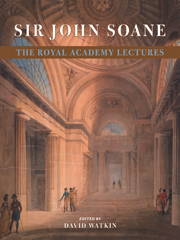Lecture VIII
from The Royal Academy Lectures
Published online by Cambridge University Press: 12 October 2018
Summary
MR PRESIDENT, - If in these discourses on architecture, a subject, as many suppose, exhausted, I venture to trespass on your patience, and on that of the members of the Institution who occasionally attend from a sense of duty, and as an example to the young students, I hope to stand excused from a due consideration of the importance of architecture from a political and moral point of view, and likewise from the duty I am called on to perform towards my young friends, the students in architecture.
From the remains of the great works of Greece and Italy, once the glory of Athens and the boast of Imperial Rome, the students in architecture must form their principles of sound construction and classical taste. To build for an eternal duration was the great object, and true wisdom of the early nations.
Among the Egyptians, the Greeks, and the Romans, this glorious principle was carried out to an almost incredible extent. On this principle, regardless of expense and difficulties of every kind, the great works of remote antiquity were raised. With this feeling for eternity the pyramids of Egypt were constructed, those stupendous monuments of human perseverance, calculated to defY the ravages of all devouring time and the convulsions of empires till that period shall arrive, when
'The cloud-cap't Towers, the gorgeous Palaces,
The solemn Temples, the great Globe itself,
Yea all which it inherit shall dissolve
And like the base-less fabric of a vision,
Leave not a rack behind.'
The ancients, in order to render their works eternal, were not satisfied with using immense blocks of granite and marble; entire buildings were sometimes formed of a single stone.
Amasis, King of Egypt, formed an edifice measuring, on the outside, twenty one cubits in length, fourteen in width, and eight in height, of one single stone, and a fact which increases our admiration is that this mighty mass was conveyed to a distance of twenty days’ journey.
The mausoleum at Ravenna of Theodoric, King of the Visigoths, is crowned by a dome of one entire piece of granite, thirty feet in diameter.
The immense obelisks, the columns of the Pantheon, and many other shafts now existing in Rome are of single blocks of granite, or marble, brought with incredible labour and difficulty from quarries in Egypt and other remote places.
- Type
- Chapter
- Information
- Sir John Soane: The Royal Academy Lectures , pp. 176 - 198Publisher: Cambridge University PressPrint publication year: 2000



